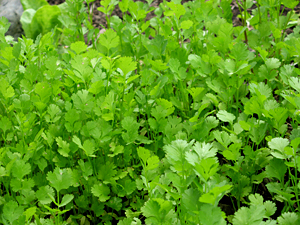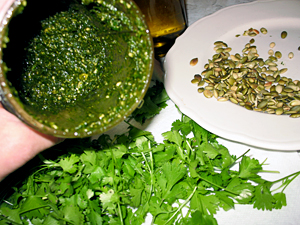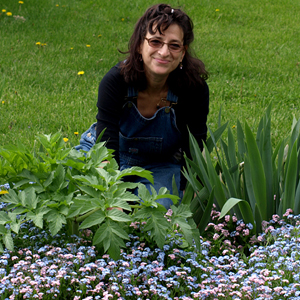Ingredients and Instructions
Fresh cut cilantro
High Quality Extra Virgin Cold Pressed Olive Oil
High Quality Sea Salt or other unprocessed Salt
Black Pepper
Raw Organic Pumpkin Seeds
[Optional: Meyer Lemon Peel, Garlic]
 I am such a lazy gardener that I had the good fortune this spring to find a million or so cilantro seedlings coming up early in the spring. This happened because last summer, I didn't bother to dig up or remove my cilantro plants after they went to seed. I harvested the cilantro seed, (known as coriander), that I wanted for our pantry and left the rest of the plants in the ground. So with every breath of wind, the plants shook their bountiful seeds all over a large section of the garden.
I am such a lazy gardener that I had the good fortune this spring to find a million or so cilantro seedlings coming up early in the spring. This happened because last summer, I didn't bother to dig up or remove my cilantro plants after they went to seed. I harvested the cilantro seed, (known as coriander), that I wanted for our pantry and left the rest of the plants in the ground. So with every breath of wind, the plants shook their bountiful seeds all over a large section of the garden.
A veritable emerald forest of young cilantro, so green & tender vibrates in the vegetable bed! I am not so great about thinning, digging up & throwing onto the compost heap sweet young lovelies such as these, so I invented this fast recipe inspired by a pesto we had when we lived in Houston many moons ago.
Upon this serendipitous discovery I created a delicious way to make use of this delicious, nutritious & fragrant herb.
Before you're in the kitchen, go to the garden with a pair of scissors & just trim that cilantro forest, snipping right close to the ground, but far enough away from the dirt, so that you don't include (too much) of the dirt in this recipe. Get yourself a big basket full of the tender darlings & bring them in & grind them up in your favorite pesto making machine, whether mortar & pestle by hand, molcajetes and tejolote (Mexican basalt mortar & pestle traditionally used to make guacamole), blender, or my gizmo of choice at the moment: a magic bullet. (no brand name advertising intended, it's just my favorite kitchen time saving machine for the moment).
 Take a handful or generous cup of pumpkin seeds & start them toasting in an unoiled frying pan over medium low heat. Sprinkle with good sea salt & start toasting themuntil you hear them begin to pop. You need to shake the pan from time to time so that they don't burn. You want to smell the lovely toasted smell of the seeds when you take them off & pour them onto a plate so they can cool off, but you don't want to cook them so much that the oils are ruined in the seeds.
Take a handful or generous cup of pumpkin seeds & start them toasting in an unoiled frying pan over medium low heat. Sprinkle with good sea salt & start toasting themuntil you hear them begin to pop. You need to shake the pan from time to time so that they don't burn. You want to smell the lovely toasted smell of the seeds when you take them off & pour them onto a plate so they can cool off, but you don't want to cook them so much that the oils are ruined in the seeds.
Then gather a good cold pressed, hopefully organic olive oil, fresh sea salt, a pepper mill & grind up the cilantro with a bit of salt mixed in to help itbreak down, then add oil, a grind of pepper to taste until the greens are emerald green & coarsely ground. Then add pumpkin seeds to taste and continue to ground up to your satisfaction. Make sure the whole is well blended with oil & voila!! Yum!
 The second batch I made of this pesto, I added some dried meyer lemon peel which really perked it up. We don't eat garlic, but if you do, I'm sure it would work quite well here too. Meyer lemons are one of my indulgences, here on the east coast of the US, we cannot possibly grow them unless you're rich enough to heat a greenhouse all summer! Hah!
The second batch I made of this pesto, I added some dried meyer lemon peel which really perked it up. We don't eat garlic, but if you do, I'm sure it would work quite well here too. Meyer lemons are one of my indulgences, here on the east coast of the US, we cannot possibly grow them unless you're rich enough to heat a greenhouse all summer! Hah!
So when I do indulge in a Meyer lemon, I make sure it is organic so that I can use the whole fruit. First, I wash them, and strip them of their peel & let the peel dry before using the juice. I love to add the peel to just about anything I can think of, from vegetable stocks to salad dressings and vegetable curries; the cilantro pesto is a great hit with this added.
Cilantro is good for digestion and is cooling to the system, which might explain why it is used so often in the cooking from hot countries like Thailand and India and Mexico. The root is also often used in Thai & Indian cooking and the plant will store best at home if you buy it with the roots attached.
According to Dr. Vasant Lad, cilantro or coriander leaf is "sweet, astringent and cooling with a sweet vipaka. It balances all doshas and is especially good for kindling gastric fire, for nausea, fever, cough and quenching thirst". He recomends it for fevers, coughs and even recommends the use of the pulp of fresh leaves on the eyelids for conjunctivitis. (From Ayurvedic Cooking for Self Healing).
 Michael Tierra says that coriander seeds are cooling & are added to hot curries to balance the heat. My experience in saving my own coriander seeds then toasting & grinding just before using is that it adds a fragrant sweetness to a dish unlike anything else.
Michael Tierra says that coriander seeds are cooling & are added to hot curries to balance the heat. My experience in saving my own coriander seeds then toasting & grinding just before using is that it adds a fragrant sweetness to a dish unlike anything else.
According to the marvelous Rebecca Wood, (as many of you know is my favorite nutritionist), cilantro is an ancient herb, popular since Egyptian times. "Cilantro supports the spleen-pancreas, stomach, bladder and lung meridians. Cilantro and corianader help regulate energy, are diuretic and specifically treat urinary tract infections. Both leaves and seeds are diaphoretic (support perspiration) and therefore treat fever. They aid digestion, relieve intestinal gas, pain, and distention and support peristalsis. They treat nausea, soothe inflammation, rheumatic pain, headaches, coughs and mental streess, and they quench thirst. The seeds and leaves are tridoshic."
Pumpkin Seeds are a good source of protein, loaded with minerals & vitamins & good fatty acids. Rebecca writes, "Pumpkin seeds are higher in protein (29%) than many other seeds and nuts, and they are a valuable source of the important Omega-3 fatty acids. An excellent source of iron, zinc, phosphorus, and vitamin A, they also contain calcium and some of he B vitamins. Raw pumpkin seeds are recommended by some ot expel pinworms or other intestinal parasites. Considered medicinal for the liver, colon and spleen-pancreas, pumpkin seeds are tridoshic or balancing to all body types, when used in moderation. They are most calming to vata."
If you have an abundance of leaves in your garden & just want to preserve them as long as possible, another tip (which I also do with my basil in the chaos of summer's profusion) is to simply grind up as much as you can with a good olive oil so that it is bound in the oil, run a knife through the jar to get any air bubbles out & then set a layer of oil on top of the jar, cover & put in the fridge. I have had basil last up to a few months this way & will try the cilantro this year, since it really seems to be calling my name!
Bon appetit!
Resources:
The New Whole Foods Encyclopedia by Rebecca Wood, winner of the James Beard & Julia Child/IACP Awards (everyone needs a copy of this book in their pantry bookshelf!
Ayurvedic Cooking for Self Healing by Usha Lad & Dr. Vasant Lad
The Way of Herbs by Michael Tierra, L.Ac., O.M.D. Jane Sherry, one of the Founders of Satya Center is a Reiki practitioner/teacher, spiritual counselor, creator of healing art talismans, healing gardens & loves to cook! She has a background in the visual arts before moving into the healing arts and has been a longtime lover of herbs & spices & cooking. She formerly lived in the Hudson Valley farm country in upstate NY where she grew medicinal & culinary herbs, as well as flowers & vegetables. She works the Satya Center healing practice with co-founder and husband, Curtis Lang and co-operates the Satya Center Crystal Gallery and web portal. You will always find crystals in among the herbs, flowers & vegetable beds! Jane & Curtis have moved to Boca Raton, Florida, about one hour north of Miami, where they are currently exploring the area, learning about the local climate and plants and designing a suburban vegetable, herb, spice, fruit and flower garden by the swimming pool!
Jane Sherry, one of the Founders of Satya Center is a Reiki practitioner/teacher, spiritual counselor, creator of healing art talismans, healing gardens & loves to cook! She has a background in the visual arts before moving into the healing arts and has been a longtime lover of herbs & spices & cooking. She formerly lived in the Hudson Valley farm country in upstate NY where she grew medicinal & culinary herbs, as well as flowers & vegetables. She works the Satya Center healing practice with co-founder and husband, Curtis Lang and co-operates the Satya Center Crystal Gallery and web portal. You will always find crystals in among the herbs, flowers & vegetable beds! Jane & Curtis have moved to Boca Raton, Florida, about one hour north of Miami, where they are currently exploring the area, learning about the local climate and plants and designing a suburban vegetable, herb, spice, fruit and flower garden by the swimming pool!

